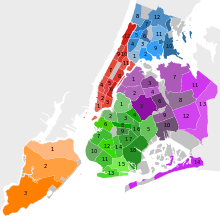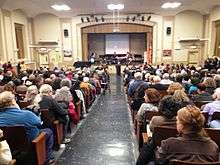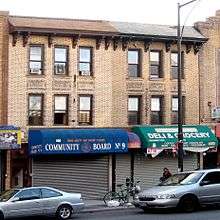Community boards of New York City

The community boards of the New York City government are the appointed advisory groups of the community districts of the five boroughs. There are currently 59 community districts: twelve in Manhattan, twelve in the Bronx, eighteen in Brooklyn, fourteen in Queens, and three in Staten Island:[1]
- Community boards of Manhattan
- Community boards of the Bronx
- Community boards of Brooklyn
- Community boards of Queens
- Community boards of Staten Island
They advise on land use and zoning, participate in the city budget process, and address service delivery in their district.[2] Regarding land use they are only advisory and mostly serve as mobilizing institutions for communities opposed to specific projects.[3] The City Charter also allows boards to submit their own plans for the development, growth, and improvement of their communities.[4][5][6]
Community boards are each composed of up to 50 volunteer members appointed by the local borough president, half from nominations by City Council members representing the community district (i.e., whose council districts cover part of the community district).[1][7] Each community board is led by a district manager, with an office and staff, whose primary purpose is to coordinate the delivery of services to the community.[1][2] Non-board members may also join or work on board committees.[1] Each borough also has a borough board, composed of the borough president, council members from the borough, and the chairperson of each community board in the borough.[8]
Responsibilities
Community boards act in an advisory capacity, wielding no official authority to make or enforce laws.[1][2]
Land use and zoning
Under the City Charter's Uniform Land Use Review Procedure (ULURP), after the Department of City Planning certifies as complete an application respecting the use, development, or improvement of real property, affected community boards (along with borough boards) may hold public hearings and submit recommendations for consideration to the City Planning Commission before its decision.[9][4] Such applications include those that involve city land or facilities, changes to zoning, and the use of public street and sidewalks.

The Board of Standards and Appeals generally has jurisdiction over special-use permits of a local nature (along with zoning variances), such as for gas stations, clubs, camps and public utility installations, and its approval process deviates from the ULURP by allowing community and borough boards to review and recommend applications; the City Planning Commission retains jurisdiction for projects that have greater impact or involve planning issues beyond the local neighborhood.[10] Projects that are "as-of-right" (i.e. the city has no discretion) are not subject to community review. The City Charter also allows community boards to submit their own plans for the development, growth, and improvement of their communities.[4][5] However, few community boards have taken advantage of this ability.[6]
Community boards serve as mobilizing institutions for communities opposed to specific projects.[2] They allow the community to articulate their opposition, and when successful, developers or the city are forced to modify projects or negotiate with the community, sometimes through the board.[2]
Service delivery
Each community board is led by a district manager, with an office and staff, whose primary purpose is to coordinate the delivery of services to the community.[1][2] Each community district also has a district service cabinet (DSC) with representatives of agencies that deliver local services.[2][11][12] In practice, boards serve in an outreach and complaint-handling capacity but have little substantive impact on tailoring service delivery.[2]
City budget
Community boards assess the needs of their own neighborhoods, meet with city agencies and make recommendations in the city's budget process to address them. Although boards have at times played a role in capital budgeting, their impact has been minimal.[6]
Structure
| Borough | Borough President (B.P.) |
Number of Districts |
Max. number of B.P. appointees |
Max. number of all appointees |
|---|---|---|---|---|
| The Bronx | Ruben Diaz Jr. | 12 | 300 | 600 |
| Brooklyn | Eric Adams | 18 | 450 | 900 |
| Manhattan | Gale Brewer | 12 | 300 | 600 |
| Queens | Melinda Katz | 14 | 350 | 700 |
| Staten Island | James Oddo | 3 | 75 | 150 |
Each board is composed of up to 50 volunteer members, with half of the membership appointed by the local borough president each year for two-year terms.[1][7] One half of the appointees are chosen on the volition of the borough president, and half from nominations by City Council members representing the community district (i.e., whose council districts cover part of the community district).[1][7] Board members are selected from among active and involved people of each community and must reside, work, or have some other significant interest in the community.[1] There are no term limits.[7] Additionally, all City Council members representing the community district are non-voting, ex officio board members.[7] Meetings occur once a month and are open to the public.[1] Appointments to the board are usually made each spring. The minimum age to become a board member was lowered to 16 years old in 2014.[13][14]

Each community board is led by a district manager, with an office and staff, whose primary purpose is to coordinate the delivery of services to the community.[1][2] While the main responsibility of the district manager's office is to receive complaints from community residents, they also process permits for block parties and street fairs, organize tenants associations, and coordinate neighborhood cleanup programs.[1]
Each community board has committees that do most of the planning and work on the issues that are brought to action at board meetings.[1] Committees may be functional committees that deal with specific New York City Charter mandates (e.g., land use review and budget committees), or agency committees that relate to a particular agency (e.g. police and sanitation committees), or otherwise.[1] Non-board members may apply to join or work on board committees, which helps provide additional expertise and manpower.[1]
Each community district also has a district service cabinet (DSC) that coordinates city services and programs, considers interagency problems and impediments, and plans multi-agency projects, within the district.[11][12] Its members include the district manager, chairperson of the community board, representatives of the agencies that deliver local services to the community district, City Council members whose district includes any part of the community district, and a representative of the Department of City Planning.[2][12][15] DSC meetings are not subject to New York's Open Meetings Law and therefore need not be open to the public.[12]
See also
References
- 1 2 3 4 5 6 7 8 9 10 11 12 13 14 15 "About Community Boards". NYC Mayor's Community Affairs Unit. Retrieved 26 November 2016.
- 1 2 3 4 5 6 7 8 9 10 Berg, Bruce (2007). New York City Politics: Governing Gotham. Rutgers University Press. p. 277.
- ↑ Berg 2007, pp. 277-278.
- 1 2 3 Angotti, Tom (August 10, 2010). Land Use and the New York City Charter (PDF). p. 4.
- 1 2 New York City Charter § 197-a
- 1 2 3 Berg 2007, p. 278.
- 1 2 3 4 5 New York City Charter § 2800(a)
- ↑ New York City Charter § 85(a)
- ↑ New York City Charter § 197-c
- ↑ Nolon, John (2001). Well Grounded: Using Local Land Use Authority to Achieve Smart Growth. Environmental Law Institute. p. 93.
- 1 2 New York City Charter § 2705(b)
- 1 2 3 4 "The District Service Cabinet Introduction" (PDF). Bronx Community Board 4. Retrieved 26 November 2016.
- ↑ Kostro, Zak (January 12, 2018). "Diaz launches youth movement for community board members". The Riverdale Press. Retrieved 21 January 2018.
- ↑ Peltz, Jennifer (Nov 29, 2014). "New York teens will have new say in city's government". PBS NewsHour. Associated Press. Retrieved 21 January 2018.
- ↑ New York City Charter § 2705(a)